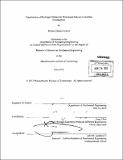Construction of prototype system for directional solvent extraction desalination
Author(s)
Fowler, Michael James
DownloadFull printable version (2.458Mb)
Other Contributors
Massachusetts Institute of Technology. Dept. of Mechanical Engineering.
Advisor
Gang Chen.
Terms of use
Metadata
Show full item recordAbstract
Directional solvent extraction has been demonstrated as a low temperature, membrane free desalination process. This method dissolves the water into an inexpensive, benign directional solvent, rejects the contaminants, then recovers pure water, and re-uses the solvent. In order to bring this technology closer to real world application, a continuous process prototype for a directional solvent extraction system was developed and tested. Octanoic acid was used as the solvent of choice, and a system capable of producing up to 7 gallons per day of fresh water was constructed. The system was tested to effectively desalinate the feed water, and the total system power was less than 7 kW. The system was constructed and first tested to run fresh water and solvent through it. Fresh water was dissolved in and separated, as expected, from the solvent at a rate of about 2 gpd. Saline water containing 3.5% sodium chloride was then used as feedwater and the desalinated water was recovered at a rate of about 1 gpd with an average salinity of 0.175%. Effective continuous operation of the directional solvent extraction prototype was demonstrated. Certain design improvements to increase efficiency, optimize component sizes, and decrease energy consumption are suggested. The demonstrated system has a wide range of applications, including production of fresh water from the sea, as well as, treatment of produced and flowback water from shale gas and oil extraction.
Description
Thesis (S.B.)--Massachusetts Institute of Technology, Dept. of Mechanical Engineering, 2012. Cataloged from PDF version of thesis. Includes bibliographical references (p. 37-38).
Date issued
2012Department
Massachusetts Institute of Technology. Department of Mechanical EngineeringPublisher
Massachusetts Institute of Technology
Keywords
Mechanical Engineering.